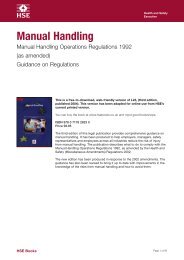Making Companies Safe - what works? (CCA ... - Unite the Union
Making Companies Safe - what works? (CCA ... - Unite the Union
Making Companies Safe - what works? (CCA ... - Unite the Union
You also want an ePaper? Increase the reach of your titles
YUMPU automatically turns print PDFs into web optimized ePapers that Google loves.
Also, presentation of <strong>the</strong> moral and social case to a more general audience would be<br />
expected to bring benefits in terms of creating support for and acceptance of new legislation,<br />
HSE enforcement activity, and <strong>the</strong> need for HSE to be adequately resourced. It might also help<br />
to create an environment where accusations of over-zealous enforcement and burdensome<br />
and unnecessary regulatory restrictions are given little credence.<br />
However, presentation of <strong>the</strong> moral and social case is undermined by inadequate resourcing<br />
and under-enforcement of existing regulations since it conveys an impression that<br />
Government does not take violation of health and safety law seriously. Campaigns to ‘win<br />
hearts’ in o<strong>the</strong>r contexts – for example in relation to <strong>the</strong> unacceptability of domestic violence<br />
or speeding – report that a combination of educational techniques and a ‘zero tolerance’<br />
approach to enforcement of <strong>the</strong> law have been most effective. Perhaps <strong>the</strong> same<br />
lessons could be usefully applied in <strong>the</strong> context of occupational health and safety.<br />
Reputational Risk and O<strong>the</strong>r HSE Initiatives<br />
Where fear of adverse publicity and loss of corporate credibility is a significant motivator for<br />
large, reputationally sensitive firms, or firms operating in high-risk sectors, <strong>the</strong> evidence<br />
suggests that <strong>the</strong>re are o<strong>the</strong>r regulatory and legal strategies that are likely to be effective.<br />
These include: mandatory occupational health and safety performance reporting; formal<br />
‘adverse publicity’ orders; <strong>the</strong> regular and widespread naming and shaming of non-compliant<br />
and dangerous organisations and <strong>the</strong>ir directors. 72<br />
HSC/E has gone some way towards developing new levers that might be expected to<br />
motivate large employers’ concern for <strong>the</strong>ir image and credibility. For instance, <strong>the</strong> HSC/E have<br />
developed a Health and <strong>Safe</strong>ty Performance Index for use by investors and insurers,<br />
challenged top 350 FTSE firms to publicise <strong>the</strong>ir health and safety performance in Annual<br />
Reports, and created an offences database that can be accessed directly by <strong>the</strong> public.<br />
However, recent HSC/E initiatives may be failing to fully take advantage of companies’<br />
reputational fears. For instance, <strong>the</strong> publication of health and safety information in Annual<br />
Reports is an entirely voluntary initiative and as such may not provide a sufficient incentive to<br />
companies to improve <strong>the</strong>ir performance. In relation to <strong>the</strong> publication of HSE’s prosecutions<br />
and notices database, <strong>the</strong> HSE contemplated and <strong>the</strong>n rejected <strong>the</strong> option of publishing a<br />
league table which ranked offenders ei<strong>the</strong>r according to number of convictions per year or<br />
according to size of fines. 73<br />
The HSE expressed a number of reservations concerning <strong>the</strong> publication of a league table,<br />
including concerns that a league table could “harm investment and contract success<br />
(especially in relation to SMEs)”, and that publication of a league table “risks general criticism<br />
and a bad reaction from industry… on <strong>the</strong> basis that we are fostering a culture of blaming<br />
employers and pursuing <strong>the</strong>m in an oppressive manner.” Instead <strong>the</strong> HSE opted to publish<br />
convictions on a continuous basis on <strong>the</strong>ir website. The HSE prosecutions and notices<br />
database can hardly be said to entail a public ‘shaming’ of <strong>the</strong> worst health and safety<br />
offenders since offenders are not ranked, and it does appear from <strong>the</strong> reservations expressed<br />
by HSE that shaming offenders was precisely <strong>what</strong> <strong>the</strong> HSE wanted to avoid. It is also<br />
interesting to note that whilst it has been proposed that <strong>the</strong> HSE should undertake “fur<strong>the</strong>r<br />
work to increase <strong>the</strong> exercise of client pressure”, 74 <strong>the</strong> HSE also appear to be more concerned<br />
about harming contract success for individual companies through <strong>the</strong> publication of adverse<br />
health and safety information.<br />
Promoting <strong>the</strong> Positive?<br />
Since research suggests that poor health and safety perfomance may negatively impact on a<br />
company’s reputation, but that <strong>the</strong> converse is not true – that is, good health and safety<br />
performance does not currently offer a competitive advantage to firms 75 – it has been argued<br />
that strategies should also be devised to publicise and reward good performance. 76 There are<br />
already a number of such initiatives at both national and European levels. However, <strong>the</strong><br />
question of <strong>what</strong> performance to award is absolutely crucial and one problem with<br />
<strong>the</strong>se initiatives has been that companies awarded for good OHS practices in one area have<br />
subsequently been found to be poor performers in relation to some o<strong>the</strong>r aspect of OHS.<br />
79
















